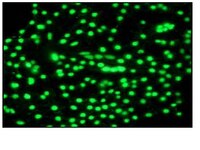Activation of DNA Damage Response Pathways during Lytic Replication of KSHV.
Hollingworth, R; Skalka, GL; Stewart, GS; Hislop, AD; Blackbourn, DJ; Grand, RJ
Viruses
7
2908-27
2015
Pokaż streszczenie
Kaposi's sarcoma-associated herpesvirus (KSHV) is the causative agent of several human malignancies. Human tumour viruses such as KSHV are known to interact with the DNA damage response (DDR), the molecular pathways that recognise and repair lesions in cellular DNA. Here it is demonstrated that lytic reactivation of KSHV leads to activation of the ATM and DNA-PK DDR kinases resulting in phosphorylation of multiple downstream substrates. Inhibition of ATM results in the reduction of overall levels of viral replication while inhibition of DNA-PK increases activation of ATM and leads to earlier viral release. There is no activation of the ATR-CHK1 pathway following lytic replication and CHK1 phosphorylation is inhibited at later times during the lytic cycle. Despite evidence of double-strand breaks and phosphorylation of H2AX, 53BP1 foci are not consistently observed in cells containing lytic virus although RPA32 and MRE11 localise to sites of viral DNA synthesis. Activation of the DDR following KSHV lytic reactivation does not result in a G1 cell cycle block and cells are able to proceed to S-phase during the lytic cycle. KSHV appears then to selectively activate DDR pathways, modulate cell cycle progression and recruit DDR proteins to sites of viral replication during the lytic cycle. | 26057167
 |

















